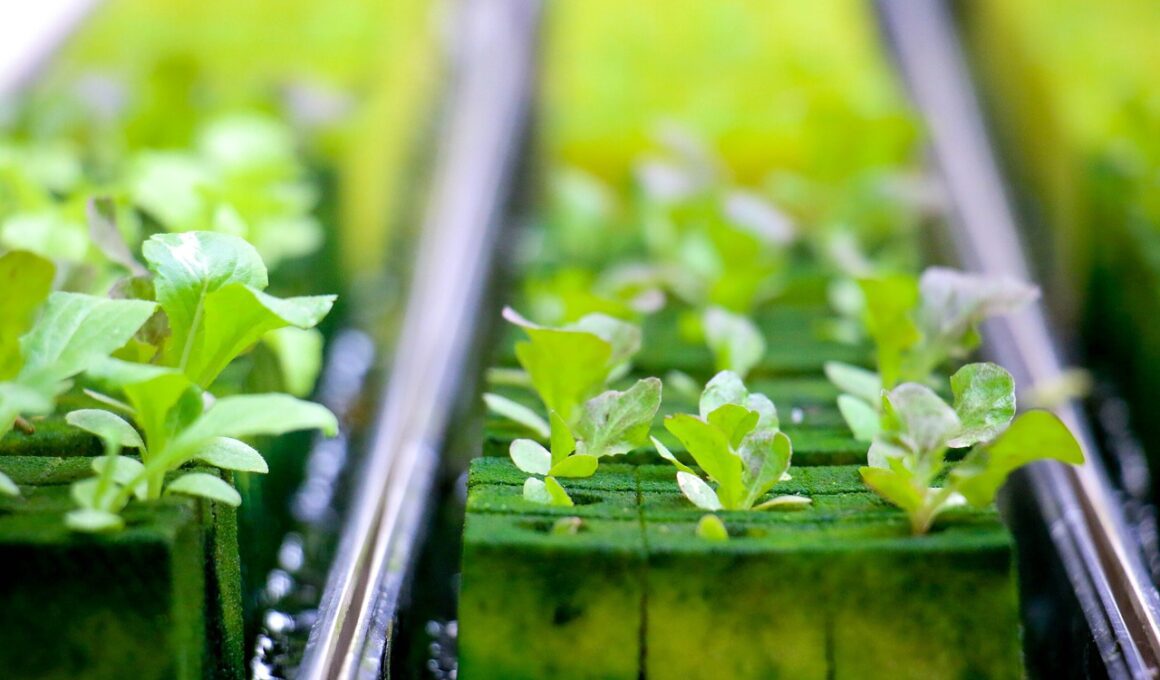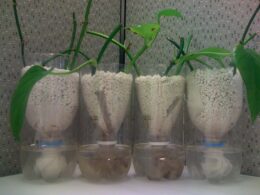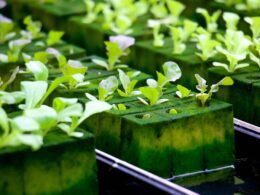Are you worried about the safety of the food you eat? If you’re like most people, you want to make sure that the food you consume is free from harmful bacteria like E. coli. This is especially true when it comes to leafy greens like lettuce, which are often linked to E. coli outbreaks.
But what about hydroponic lettuce? Can it get contaminated with E. coli too?
The answer is yes, hydroponic lettuce can get contaminated with E. coli just like any other type of lettuce. However, there are precautions that can be taken to ensure its safety.
In this article, we’ll explore the issue of E. coli contamination in hydroponic lettuce, and what steps can be taken to make sure that the lettuce you eat is safe and free from harmful bacteria.
So, sit back and relax as we delve into the world of hydroponic lettuce and E. coli contamination.
Understanding E. coli contamination
You might be surprised to learn that the culprit behind many foodborne illnesses is a type of bacteria commonly found in the digestive tract of animals and humans. Escherichia coli (E. coli) is a gram-negative, rod-shaped bacteria that can cause severe abdominal cramps, bloody diarrhea, and vomiting.
Understanding E. coli transmission is crucial in preventing its spread, especially in produce like lettuce. While E. coli is mostly harmless, some strains can cause serious infections. The most common way E. coli spreads is through contaminated food or water. Produce like lettuce can become contaminated with E. coli if it comes in contact with contaminated soil, water, or animal waste.
Risks of E. coli contamination in produce can be reduced by washing and cooking the produce thoroughly. To prevent E. coli contamination, it’s important to practice good hygiene and food safety. Wash your hands thoroughly before and after handling food, and make sure to cook meat and poultry to the appropriate temperature. When handling produce, wash it thoroughly under running water and avoid cross-contamination with raw meat or poultry.
Understanding E. coli transmission and taking appropriate measures to prevent its spread can help keep you and your family safe from foodborne illnesses.
Hydroponic lettuce and E. coli
It’s important to be aware of potential bacterial contamination when growing leafy greens, even in hydroponic systems. While hydroponic lettuce is generally considered safer than traditional soil-grown lettuce, there is still a risk of E. coli contamination.
E. coli contamination can occur in hydroponic systems if proper sanitation and hygiene practices are not followed. For example, contaminated water or equipment can easily spread the bacteria to the lettuce plants. It’s essential to regularly clean and sanitize all equipment and to use clean, filtered water in hydroponic systems.
Despite the risk of contamination, hydroponic lettuce still offers many nutritional benefits and can be grown using sustainable practices. Hydroponic systems use less water and fewer pesticides than traditional farming methods, making them a more environmentally friendly option.
With proper precautions and attention to hygiene, hydroponic lettuce can be a safe and healthy addition to your diet.
Does the Shelf Life of Hydroponic Lettuce Affect the Likelihood of E. Coli Contamination?
The shelf life of hydroponic lettuce plays a significant role in determining the likelihood of E. coli contamination. If the lettuce is not properly stored and its shelf life is extended, the risk of contamination increases. Maintaining a shorter shelf life through proper refrigeration and storage practices can help reduce the probability of E. coli contamination in hydroponic lettuce.
Ensuring the safety of hydroponic lettuce
When it comes to ensuring the safety of hydroponic lettuce, there are three key points to consider. First, it’s important to follow best practices for preventing E. coli contamination, such as using proper sanitation and monitoring water quality.
Second, there are regulations and standards set in place for hydroponic lettuce production that must be followed.
Finally, as a consumer, you play a role in ensuring the safety of the lettuce you purchase by properly handling and storing it.
Best practices for preventing E. coli contamination
To keep your homegrown greens free from harmful bacteria, follow these simple tips for preventing contamination.
First and foremost, always practice good hygiene when handling your plants. Wash your hands thoroughly before and after touching your hydroponic system, and make sure that any tools or equipment you use are properly sanitized. This will help to reduce the risk of introducing harmful bacteria into your growing environment.
Additionally, it’s important to regularly monitor and maintain the cleanliness of your hydroponic system. Be sure to regularly clean and sanitize all components of your system, including the reservoir, air stones, and tubing. Using a food-grade sanitizer can help to ensure that any potential sources of contamination are eliminated.
By following these basic sanitation measures, you can help to prevent the growth of harmful bacteria and ensure that your hydroponic lettuce is safe for consumption.
Regulations and standards for hydroponic lettuce
Regulations and standards ensure that your homegrown hydroponic lettuce is safe to eat. The industry is closely monitored and regulated, with safety standards in place to prevent E. coli contamination. These standards cover everything from the quality of the water used to the cleanliness of the equipment used in the growing process.
Hydroponic lettuce is subject to the same safety regulations as conventionally grown lettuce. The industry is held to high standards to ensure the safety of the consumer. These regulations are constantly being updated and improved to stay ahead of potential risks.
So, rest assured that your homegrown greens are safe to eat, and you can enjoy your fresh, healthy salad without any worries.
The role of consumers in ensuring safety
Make sure you’re taking the necessary steps to ensure the safety of your homegrown greens. Follow proper sanitation and hygiene practices during the growing and harvesting process.
As a consumer, it’s crucial to educate yourself on how to handle and prepare hydroponic lettuce. This will prevent potential risks of contamination. Remember to wash your hands and tools thoroughly before handling the greens. Ensure that the water and nutrient solution used in the hydroponic system are clean and free from harmful bacteria.
After harvesting, it’s essential to properly store and handle the lettuce. Keep the greens refrigerated and separate from any raw meats or other potential contaminants. Wash the lettuce thoroughly with clean water before consuming to remove any dirt, debris, or bacteria that may have accumulated during the growing process.
Implementing these food handling practices can help ensure that your hydroponic lettuce is safe to eat and free from any harmful bacteria such as E. coli.
Comparing hydroponic and soil-grown lettuce safety
Ensuring the safety of our greens is crucial for our well-being and peace of mind. When it comes to lettuce, there are two main ways it can be grown: hydroponically and in soil. So, which is safer?
Hydroponic lettuce is grown in a controlled environment, where the water and nutrients are carefully monitored and regulated. This means that there’s less risk of contamination from outside sources, such as animal manure or contaminated soil. Additionally, since hydroponic lettuce isn’t grown in soil, there’s less risk of soil-borne pathogens like E. coli.
However, that’s not to say that hydroponic lettuce is completely risk-free. It’s still possible for contamination to occur during the growing or handling process, especially if proper food safety protocols aren’t followed.
As a consumer, it’s important to ensure that you’re purchasing your lettuce from a reputable source, and to always wash it thoroughly before consuming. By taking these precautions, you can enjoy the benefits of both hydroponic and soil-grown lettuce while minimizing the risk of foodborne illness.
Conclusion: Is hydroponic lettuce safe from E. coli?
It’s important to be aware of the potential risks associated with consuming greens and take necessary precautions to protect our health. When it comes to lettuce, there is always a concern about E. coli contamination, whether it’s hydroponic or soil-grown. However, there are ways to prevent this harmful bacterium from infecting our greens.
Here are five E. coli prevention techniques that can be applied to both hydroponic and traditional farming methods:
-
Use clean water: Make sure the water used in the hydroponic system is free from contamination. For soil-grown lettuce, use only clean water for irrigation.
-
Proper sanitation: Maintain clean and sanitary conditions in the hydroponic system or farm. This involves regular cleaning and disinfecting of equipment and surfaces.
-
Safe handling: Proper handling of lettuce from harvest to consumption can prevent E. coli contamination. This includes washing hands before handling lettuce, refrigerating lettuce promptly, and storing it away from raw meat.
-
Testing: Regular testing of the lettuce and the water used in hydroponic systems can help detect any potential E. coli contamination.
-
Traceability: Keeping track of the origin of the lettuce can help identify the source of contamination in case of an outbreak.
In summary, hydroponic lettuce is just as safe as soil-grown lettuce when it comes to E. coli contamination. By following the above prevention techniques, the risk of E. coli infection can be minimized. So, enjoy your greens with peace of mind, knowing that you’ve taken the appropriate steps to protect your health.
Frequently Asked Questions
What are the symptoms of E. coli contamination in humans?
If you suspect that you may have been contaminated with E. coli, there are a few symptoms you should look out for. These symptoms include diarrhea, stomach cramps, and vomiting. In some cases, the symptoms can be severe and even life-threatening.
If you experience any of these symptoms, it’s important to seek E. coli treatment right away. To prevent E. coli contamination, there are some prevention measures you should take. These measures include regularly washing your hands, cooking meat thoroughly, and avoiding cross-contamination between raw and cooked foods.
By taking these simple steps, you can reduce your risk of E. coli contamination and keep yourself and your family safe.
How is E. coli contamination typically spread in lettuce?
To prevent E. coli contamination in lettuce, it’s important to understand the sources of contamination. This can include contaminated water, soil, or equipment used during processing. Prevention measures such as proper sanitation and testing can help reduce the risk of contamination.
It’s important to always wash lettuce thoroughly before consuming, regardless of whether it’s hydroponic or grown in soil. Keep in mind that E. coli contamination can also occur during food preparation, so make sure to properly clean surfaces and utensils. By taking these precautions, you can decrease the likelihood of getting sick from E. coli-contaminated lettuce.
Is there a difference in the E. coli risk between different types of lettuce, such as romaine versus iceberg?
When it comes to lettuce varieties and E. coli risk, there are some differences to consider. While all types of lettuce can potentially be contaminated with E. coli, studies have shown that certain varieties may be more susceptible than others.
For example, romaine lettuce has been linked to several E. coli outbreaks in recent years, while iceberg lettuce has had fewer reported cases. However, it’s important to note that the risk of contamination can vary depending on a variety of factors, such as growing conditions and handling practices.
Ultimately, it’s important to always practice good food safety habits when handling any type of lettuce, whether it’s romaine, iceberg, or hydroponic.
Can E. coli contamination occur in hydroponic systems that use organic fertilizers?
When it comes to using organic fertilizers in hydroponic systems, there are both benefits and drawbacks. While organic fertilizers can provide a more natural source of nutrients for plants, they may also increase the risk of exposure to harmful bacteria, such as E. coli.
However, it’s important to note that hydroponic lettuce has been shown to have lower E. coli levels compared to soil-grown lettuce. Additionally, hydroponic systems offer more control over nutrient content, allowing for customization to meet specific plant needs.
So while there may be a slightly higher risk of E. coli contamination in hydroponic systems that use organic fertilizers, the overall benefits of hydroponics may outweigh this potential drawback.
How do hydroponic growers monitor and prevent E. coli contamination in their lettuce crops?
When it comes to hydroponic lettuce, food safety regulations are taken seriously by growers. Hydroponic technology allows for precise monitoring and control of the growing environment, which helps prevent contamination by pathogens like E. coli.
Growers use a variety of methods to ensure their crops are safe, such as testing the water and nutrient solution for pathogens, using clean equipment and facilities, and following strict hygiene protocols. Even though hydroponic lettuce is less likely to be contaminated than conventionally grown lettuce, growers still take extra precautions to ensure their crops are safe for consumption.
Conclusion
So, is hydroponic lettuce safe from E. coli contamination? The answer is yes, but with a caveat.
While hydroponic systems are less prone to E. coli contamination than soil-grown lettuce, it is still important to take precautions to ensure the safety of your hydroponic lettuce.
To ensure the safety of your hydroponic lettuce, make sure to use clean water and sterile equipment, and always wash your hands thoroughly before handling the plants. It’s also important to monitor the pH and nutrient levels of your hydroponic system and to properly dispose of any plant material that may have come into contact with E. coli.
When comparing hydroponic and soil-grown lettuce safety, it’s clear that hydroponic systems are generally safer due to the controlled environment and lack of exposure to soil-borne pathogens. However, it’s still important to take proper precautions to ensure the safety of your hydroponic lettuce and to be aware of any potential risks.
By following these guidelines, you can enjoy delicious and safe hydroponic lettuce without worrying about E. coli contamination.









